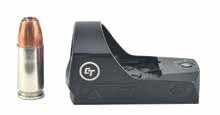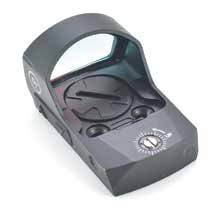The secret to shooting a handgun correctly has been boiled down to three words — Front Sight, Press. Anyone can line up the sights correctly. Anyone can activate a trigger. But can you line up the sights and then activate the trigger so that the alignment of the sights is not disturbed until the bullet leaves the muzzle? Then, add in the complicating factor that when the human mind feels the need to go fast, it wants you to look at the target, not the front sight. Stress does interesting things to your ability and your willingness to put your focus on the front sight. So does age. The military recognized this and started experimenting with the red dot–sight concept around 1970. Those concepts have been developed, tested, and accepted to the point where they are now standard equipment for almost everyone who carries a rifle in battle.
Those same principles work for shooters who feel the need for speed with a pistol, whether for self-defense, competition, or hunting. When using a red dot, keep both eyes open, look through the view-port, focus on the target, and superpose the red dot on the point of aim. That “activate the trigger smoothly” thing still comes up, but a red dot greatly simplifies aiming.
In the March 2020 issue, we provided a look at four modern everyday-carry (EDC) pistols with slide-mounted red dots. We compared accuracy and times required for various drills between the pistols and added in a comparison of some drills without the optics. The pistols that were red-dot equipped showed much higher scores than those without. Our methodology in that test was to use multiple pistols with the same or a very similar optic (Shield RMSc and SMSc). After publication, one of our readers contacted us and requested that, next time, we test red dots instead of the pistols. With that goal in mind, we selected a SIG Sauer X5 9mm Luger ($999) – currently one of the hottest pistols for the United States Practical Shooting Association’s (USPSA.org) Carry Optics division — as the test bed, along with a selection of red-dot sights, that would be appropriate for competition, hunting, or self-defense. Sights chosen were the Vortex Razor RZR-2003, $500; the Trijicon SRO SRO2-C-2500002, $750; the SIG Sauer Romeo 1PRO SOP1P101, $440; and the Crimson Trace CTS-1250 01-00560, $259.
How We Tested
We used a different testing routine than normal for this group. First, we did the testing with a single pistol with a single optic mounted over an extended period of time. We sighted in each red dot in turn, then shot them for groups at American Shooting Centers in west Houston. We shot the pistol/optic combo in practice for about a month, then finished everything off with a USPSA match.

Our biggest challenge/concern with the red dots has been mating them to the pistol. Rifles are well known for needing specific mounts for a specific model. We’re not sure why, but we never considered that before commencing this test, and we had issues. We needed an adapter to mount everything to the SIG X5. Even the SIG Romeo1Pro didn’t fit the SIG X5 without an adapter. Also, we found out the hard way that a SIG X5 and a SIG X5 Legion use different adapters! That required some careful work with a flat file.
We used Springer Precision (SpringerPrecision.com) for our adapter plates. Springer provided quick service and some great tech support, but we still had to improvise then find some extra 6-48 screws online. C&H Precision Weapons (chpws.com) also offers some adapters. The easy solution might be to look for a sight with the Docter pattern. Perhaps the manufacturers could post a list online of what adapters worked with which pistols? Could a more universal mount be created, as with a Picatinny rail? All things considered, we were impressed. We remember the early red dots when they were introduced to USPSA competitions in the late 1980s. What we tested here are light years ahead of those. To confirm our trust in this technology, our personal EDC, home defense, and competition pistols all mount good red dots.
We used the same Remington 115-grain 9mm ammo for all shooting tests. Here’s what we found:
Gun Tests Grade: B+ (BEST BUY)
$259
Crimson Trace (CT) has been around since 1994 and has developed a sterling reputation for its laser sighting devices, even providing free batteries for life. CT was purchased by Smith & Wesson in 2016. CT introduced a series of red-dot sights for pistols in late 2018.
| Weight | 1.3 oz. |
| Length | 1.89 in. |
| Width | 1.185 in. |
| Dot Size | 3.25 MOA |
| Height Above Slide | 1.025 in. |
| Sight Window | Oval, 1.07 in. x 0.68 in. |
| Mount Type | Springer Precision |
| Battery Type | CR1632 |
| Battery Change | Top, unscrew slotted cover |
| Estimated Battery Life | ~50,000 hours at medium setting |
| Control Location | Left side |
| Warranty | 3 year limited |
| Telephone | (800) 442-2406 |
| Website | CrimsonTrace.com |
| Made In | China |

The CTS 1250 is a compact dot with some big features. It is not compact enough to fit on our SIG P365XL, but an adapter to the Docter footprint for the SIG X5 worked just fine. Even with the adapter plate, it sat only 1.06 inches maximum above the slide, by our measurement. That is roughly the same size as the SIG Romeo1Pro. The red dot subtends 3.25 minutes of angle (MOA) and is user adjustable for three night vision and seven daylight settings. The night-vision levels could create some extra utility in tactical use. Brightness levels are adjusted via two buttons on the left side of the sight body.
Power is provided by a single CR1632 battery. Estimated run times are as high as 50,000 hours on a medium setting. That should last us more than a few matches. Battery life is extended by the use of intelligent power management when the unit is dormant. The sight enters sleep mode after 10 hours on inactivity. Pushing the Up button turns things back on again. This lessens our fear of the sight turning itself off after a short period of time — usually right when the emergency starts. The battery compartment opens from the top via rotation and removal of a slotted cap. The CTS 1250 is listed as being shock, impact, and water resistant. A rubberized cap is provided for protection when not in use. There is a three-year limited warranty and, once again, free batteries for life!
Our Team Said: A fairly compact sight rising just over an inch above the slide, the CTS 1250’s dot was easy to find and track. And it uses a standard Docter footprint. We thought the feature-to-cost ratio of this sight — including free batteries for life — was excellent.




























